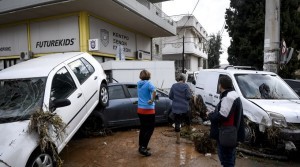“When the Atlantic hurricane season begins to quiet down in late October and November, it’s time to cast an eye toward the Mediterranean Sea for “medicanes”–a nickname for storms that develop tropical characteristics just off the coast of southern Europe,” said Weather Underground’s Bob Henson in a Washington Post report.
According to the U.S. newspaper report, the Mediterranean storm that has hit the region was centered around Sicily on Wednesday, but Greece was hit the hardest. The flooding in the industrial towns of Mandra, Nea Peramos near Athens, has cost the lives of 16 people, with six more missing and around 40 hospitalized.
The origin of the storm; named Numa in Europe, is explained by Henson:
“When the Atlantic hurricane season begins to quiet down in late October and November, it’s time to cast an eye toward the Mediterranean Sea for “medicanes”–a nickname for storms that develop tropical characteristics just off the coast of southern Europe. Medicanes aren’t considered full-fledged tropical systems, since the waters of the Mediterranean aren’t extensive or warm enough to sustain a true hurricane. And despite the implication embedded in the name, very few medicanes achieve sustained winds as strong as a Category 1 hurricane. However, it’s quite possible for an existing center of low pressure in the Mediterranean to briefly take on tropical characteristics, including a symmetric structure and a small core of warm air.”
“Numa could become a medicane over the next couple of days. Sea surface temperatures are only around [68 degrees], far too cool for classic hurricane development, but medicanes can still form over such waters if upper-level temperatures are cold enough to make the air unstable.”
Greek meteorologists: medicane will hit Greece on Saturday night
“We call it a tropical cyclone of the Mediterranean type because it visually looks like tropical cyclones. It has an “eye” – that is, an opening – and a spiral motion around it. Such phenomena occur in the Mediterranean once or twice a year. Of course, they have nothing to do with the intensity and speed of the Caribbean cyclones,” researcher of the National Observatory of Athens Costas Lagouvardos told in.gr news website. “The latest cyclone of this type appeared in Crete on October 30-31, 2016 with strong storms,” he added.
Greek scientists say that the cyclone will appear Saturday night. “Nevertheless, we are not yet in a position to know its exact course,” Lagouvardos said.
Meteorologists have named the current destructive storm “Zenon”, after the ancient Greek philosopher. However, there are disagreements within the scientific community whether such extreme weather phenomena should be given names.
Source: greekreporter.com
Ask me anything
Explore related questions





